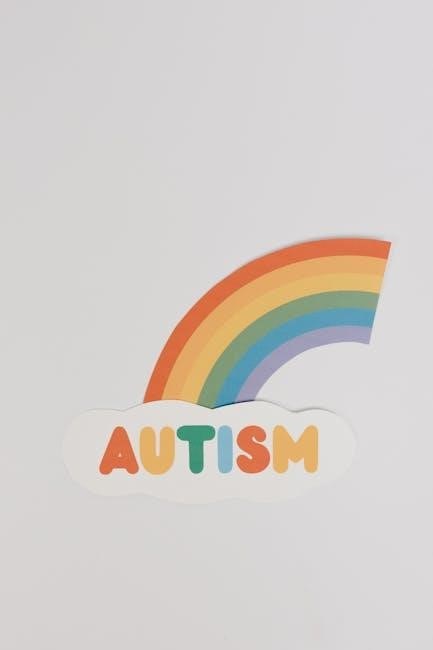Speech therapy for autism focuses on improving communication and social skills through video modeling and structured activities, with downloadable PDF resources offering practical tools for daily practice.
1.1 Importance of Speech Therapy in Autism
Speech therapy is essential for autistic individuals as it enhances communication skills, fostering social interactions and language understanding. It helps individuals express their needs, emotions, and ideas effectively, reducing frustration and anxiety. By addressing speech delays, therapy improves daily interactions and learning, making life more manageable. The use of structured activities, such as video modeling and sorting objects, supports tailored development. Downloadable PDF resources, like the 10 Essential Speech Therapy Activities, provide practical tools for consistent practice. These resources empower parents and caregivers to support speech development at home, ensuring continuous growth and confidence for autistic individuals. Early intervention and personalized approaches maximize long-term outcomes, making speech therapy a cornerstone of autism support.
1.2 Goals of Speech Therapy for Autistic Individuals
Speech therapy for autistic individuals aims to enhance communication, social interactions, and emotional regulation. Key goals include improving verbal and non-verbal skills, fostering social connections, and developing emotional awareness. Therapy focuses on boosting confidence in expressing needs and emotions, reducing communication barriers. It also emphasizes practical skills like turn-taking and attention-shifting, crucial for group activities. By addressing speech delays and language comprehension, therapy supports independence and self-advocacy. The use of science-based methods, such as video modeling, aligns with these objectives. Downloadable resources, like the 10 Essential Speech Therapy Activities PDF, provide structured tools to achieve these goals, ensuring consistent progress and tailored support for each individual’s unique needs and strengths.

Activities and Techniques in Speech Therapy
Speech therapy for autism includes activities like video modeling, sorting objects, and using picture prompts. These techniques, supported by downloadable PDF resources, aid in structured communication development.
2.1 Video Modeling: Teaching Speech Through Peer Examples
Video modeling is a science-based method where autistic children learn speech by observing peer examples. This technique, used in tools like Speech Blubs, allows kids to imitate their peers, fostering natural speech development. By watching videos of other children speaking, autistic individuals can better understand and replicate language patterns. This approach is particularly effective as it leverages visual learning strengths common in autism. Video modeling sessions often include role-playing scenarios, turning-taking exercises, and daily routines to enhance social and communication skills. Many speech therapy PDF resources incorporate video modeling activities, making it easier for parents and therapists to implement this method at home or in clinical settings. This technique aligns with other structured activities, such as sorting objects and using picture prompts, to create a comprehensive speech development program.
2.2 Sorting Objects into Categories Activity
Sorting objects into categories is a highly effective speech therapy activity for autistic children, often paired with picture prompts for enhanced understanding. This activity helps improve communication skills by encouraging children to identify and name objects, fostering vocabulary expansion. By categorizing items (e.g., animals, toys, or food), children develop organizational and problem-solving abilities while engaging in meaningful interaction. Picture prompts serve as visual aids, making it easier for autistic individuals to participate and express their thoughts. This activity also promotes social interaction, as it can be completed in pairs or groups, encouraging collaboration and turn-taking. Many free, downloadable PDF resources provide pre-designed sorting activities, making it accessible for parents and therapists to implement at home or in clinical settings. This structured approach supports language development and focus, helping children build independence in their communication journeys.
2.3 Picture Prompts for Communication Development
Picture prompts are a valuable tool in speech therapy for autistic individuals, aiding in communication development by providing visual cues. These prompts help children understand and express concepts, making abstract ideas more tangible. They are often used in activities like identifying objects, emotions, or actions, which can be tailored to the child’s interests and skill level. Many free, downloadable PDF resources offer customizable picture prompts, allowing therapists and parents to create personalized materials. This visual support enhances vocabulary, comprehension, and social interaction skills. By incorporating picture prompts into daily routines, children with autism can practice communication in a structured and engaging manner, fostering confidence and independence in their speech development. These tools are versatile and can be adapted to various learning environments, ensuring consistent progress in communication abilities.
2.4 Role-Playing Exercises for Social Skills
Role-playing exercises are a powerful tool in speech therapy for autism, designed to enhance social skills and emotional intelligence. These activities allow individuals to practice real-life interactions, such as initiating conversations or understanding social cues, in a safe and controlled environment. By simulating scenarios like sharing toys or greeting peers, autistic children can build confidence and reduce anxiety related to social interactions. Many PDF resources offer structured role-playing scripts and activities tailored to different developmental levels, which can be easily accessed and used by therapists and parents alike. Incorporating positive reinforcement during these exercises further encourages progress and participation, fostering empathy and cooperation essential for meaningful social connections. Regular practice helps individuals generalize these skills to various real-life situations.

PDF Resources for Speech Therapy Activities
Discover downloadable PDFs packed with engaging speech therapy activities tailored for autism, offering exercises, worksheets, and games to support communication development.
3.1 Downloadable PDF: 10 Essential Speech Therapy Activities
This downloadable PDF provides a comprehensive guide to 10 essential speech therapy activities tailored for individuals with autism. Each activity is designed to promote communication skills, from basic verbal interactions to complex social exchanges. The PDF includes step-by-step instructions, visual aids, and adaptable strategies to suit varying developmental levels. Activities focus on enhancing vocabulary, improving articulation, and fostering social communication. The resource is ideal for speech-language pathologists, educators, and parents seeking structured yet flexible tools. By incorporating these activities into daily routines, caregivers can create consistent opportunities for growth and development. The PDF is easily accessible and printable, making it a practical addition to any speech therapy program.
3.2 Free Printable Worksheets for Autism Communication
These free printable worksheets are specifically designed to support communication development in autistic individuals. They include a variety of exercises, such as vocabulary building, picture matching, and sentence formation. Many worksheets incorporate visual aids, which are particularly effective for individuals with autism. Activities are tailored to different skill levels, making them adaptable for both children and adults. Worksheets often focus on social communication skills, such as initiating conversations or understanding emotions. Parents and therapists can easily print and use these resources to create structured learning opportunities. The worksheets are also designed to be engaging, with colorful illustrations and clear instructions. They provide a cost-effective way to supplement speech therapy sessions and can be incorporated into daily routines for consistent practice.
3.3 Games and Therapy Materials in PDF Format
These engaging PDF resources offer a wide range of interactive games and therapy materials designed to make speech therapy fun and effective for autistic individuals. Activities include matching games, bingo, and puzzles that target specific communication skills. Many resources incorporate visual supports, such as symbols and pictures, to aid understanding. Interactive PDFs allow users to click and drag objects, making therapy sessions more dynamic; These materials are adaptable to different skill levels and can be used by both children and adults; They are often printable, making them easy to use in therapy sessions or at home. These games and materials provide a cost-effective way to enhance communication skills in a structured yet enjoyable manner.

Augmentative and Alternative Communication (AAC)
AAC provides alternative methods for individuals with limited speech to communicate effectively, enhancing their ability to express needs, thoughts, and emotions through tailored strategies and tools.
Augmentative and Alternative Communication (AAC) refers to methods and tools that help individuals with autism communicate effectively, especially when verbal speech is limited or challenging. AAC systems can be low-tech, such as picture communication symbols, or high-tech, like digital devices with voice output. These tools empower autistic individuals to express their needs, thoughts, and emotions, fostering independence and confidence in communication. For many, AAC is not just an alternative but a primary means of expression, enabling meaningful interactions in daily life.
The introduction of AAC in speech therapy for autism is tailored to the individual’s abilities and needs, ensuring they can participate fully in social and educational settings. By providing accessible communication strategies, AAC supports the development of language skills and enhances overall quality of life.
4.2 Picture Exchange Communication System (PECS)
The Picture Exchange Communication System (PECS) is a widely used AAC method for autistic individuals, focusing on communication through visual symbols. It teaches individuals to exchange pictures or symbols to convey messages, such as requesting items or sharing thoughts. PECS begins with simple exchanges, like giving a picture of a desired object, and progresses to more complex communication, such as combining symbols to form sentences. This method is particularly effective for those with limited verbal abilities, providing a structured and predictable way to initiate interactions. PECS is often integrated into speech therapy activities, offering a practical tool for fostering communication skills in daily routines and social interactions.
4.3 Digital AAC Devices for Speech Support
Digital AAC devices have revolutionized speech support for autistic individuals, offering a modern alternative to traditional communication methods. These devices use touch screens and voice output to help users convey messages. They are highly portable and accessible, making them ideal for daily use. Digital AAC devices often include pre-loaded vocabulary and customizable options, allowing users to express their needs effectively. They are particularly beneficial for non-verbal individuals or those with significant speech delays. Many devices also incorporate AI to predict and adapt to the user’s communication needs. By providing a reliable means of expression, digital AAC devices empower autistic individuals to participate in conversations and engage in social interactions with greater ease and confidence.

Home-Based Speech Therapy Activities
Home-based speech therapy activities empower parents to support their child’s communication development through daily routines, play, and simple exercises, fostering consistency and progress in a familiar environment;
5.1 DIY Activities for Parents to Support Speech Development
Engaging in DIY activities at home can significantly support speech development in autistic children. Parents can create simple, cost-effective tools using household items, such as labeling objects with pictures or words, encouraging interactive play with toys, or using mirrors for vocal play. Activities like singing songs with gestures or reading books with interactive elements can also foster communication; Incorporating these exercises into daily routines helps build consistency and familiarity, making learning more effective. Parents are encouraged to tailor activities to their child’s interests and abilities, ensuring a personalized approach to speech development. Consistency and positive reinforcement are key to maximizing progress.
5.2 Creating a Communication-Friendly Home Environment
Designing a communication-friendly home environment is crucial for supporting speech development in autistic individuals. Start by minimizing distractions, such as reducing background noise, to create a calm space for interaction. Use visual aids like labels, schedules, and choice boards to encourage communication. Incorporate dedicated areas for play and conversation, ensuring they are equipped with relevant materials like toys, books, and communication tools. Parents can also use reflective surfaces like mirrors to practice facial expressions and gestures. By organizing the environment in a predictable and accessible way, parents can foster a sense of security and motivation for their child to engage in speech and interaction. These adjustments help create a supportive atmosphere tailored to their child’s needs.
5.3 Incorporating Daily Routines into Speech Practice
Incorporating daily routines into speech practice provides consistent opportunities for autistic individuals to engage in communication. Morning routines, such as brushing teeth or dressing, can be paired with verbal prompts or visual schedules to encourage language use. Mealtime offers chances to practice requesting items or describing food preferences. Bedtime routines can involve reading or storytelling to enhance vocabulary and comprehension. Parents can use first-then charts to link tasks with communication goals, ensuring predictability and structure. By embedding speech practice into everyday activities, children develop practical communication skills in familiar and comforting contexts, fostering confidence and readiness to apply these skills in other settings.

Early Intervention and Speech Development
Early intervention significantly impacts speech development in autistic children. It involves tailored strategies, consistent practice, and collaboration between therapists and families. Addressing communication needs early improves long-term outcomes effectively.

6;1 The Role of Early Intervention in Autism
Early intervention plays a crucial role in autism by addressing developmental delays and communication challenges promptly. It involves tailored strategies, such as speech therapy, to enhance skills and adaptation. Specialists collaborate with families to create personalized plans, fostering a supportive environment for growth. Research shows that early intervention significantly improves long-term outcomes, including speech and social abilities. By identifying red flags early, professionals can implement therapies that help autistic children communicate more effectively. Early intervention sets the foundation for future progress, making it a cornerstone of autism support. Consistent and targeted efforts during this critical period yield meaningful results, empowering individuals to thrive.
6.2 How Early Speech Therapy Improves Long-Term Outcomes
Early speech therapy significantly enhances long-term outcomes for autistic individuals by addressing communication barriers early. It fosters better verbal and non-verbal skills, improving social interactions and emotional regulation. Research indicates that children who receive early intervention tend to have improved language abilities and academic performance. Speech therapy also supports cognitive development, helping individuals navigate daily challenges more effectively. By laying a strong foundation, early therapy reduces reliance on augmentative methods later in life. Consistent and tailored approaches empower individuals to communicate confidently, leading to greater independence and a higher quality of life. Early intervention is thus a vital investment in long-term success and well-being.
6.3 Red Flags for Speech Delays in Autistic Children
Identifying red flags for speech delays in autistic children is crucial for early intervention. Common indicators include no babbling or cooing by 6 months, no gesturing (e.g., pointing, waving) by 12 months, and no single words by 16 months. By 24 months, a lack of two-word phrases or significant delays in language development are concerning. Other signs include limited eye contact, poor response to names, and repetitive or echolalic speech. If a child experiences regression in language skills, it warrants immediate attention. Monitoring these signs helps parents and professionals address speech delays early, ensuring timely intervention and better outcomes. Early recognition is key to supporting communication development effectively.

Social Skills Development Through Speech Therapy
Speech therapy focuses on improving social interaction skills, such as initiating conversations, understanding tone, and active listening. It enhances non-verbal communication and emotional expression, vital for connections.
7.1 Group Activities for Social Interaction
Group activities in speech therapy for autism focus on fostering social interaction and communication among participants. These activities encourage collaborative play, turn-taking, and shared attention.
Examples include role-playing scenarios, group conversations, and collaborative problem-solving tasks. These settings help individuals practice social cues, initiate interactions, and respond appropriately.
Visual aids, like pictures or PECS, are often used to support understanding and participation. Such activities build confidence and reduce anxiety in social situations.
They also provide opportunities to generalize skills learned in individual therapy to real-world group settings, enhancing overall social competence and emotional intelligence.
7.2 Teaching Turn-Taking and Attention Skills
Teaching turn-taking and attention skills is crucial for improving social communication in autistic individuals. Activities like structured games, such as board games or card games, encourage taking turns and maintaining focus. Visual aids, like timers or visual schedules, help individuals understand when it’s their turn and how long to wait. Interactive exercises, such as passing objects or engaging in shared tasks, also foster turn-taking abilities. These activities promote patience, self-regulation, and the ability to engage in reciprocal interactions. By practicing these skills in a controlled environment, individuals can better navigate social situations and improve their overall communication and interaction abilities. Consistency and positive reinforcement are key to successful outcomes.
7.3 Developing Non-Verbal Communication Strategies
Developing non-verbal communication strategies is essential for autistic individuals, as many rely on these methods to express themselves. Activities like gestures, facial expression exercises, and body language games help build these skills. Using mirrors to practice facial expressions and pairing pictures with corresponding gestures can enhance understanding. Role-playing scenarios also encourage the use of non-verbal cues in real-life situations. Additionally, incorporating visual supports, such as emotion charts or gesture cards, provides clear references for learning. These strategies not only improve communication but also boost confidence and social interaction abilities. Consistent practice and positive reinforcement are key to fostering these non-verbal skills effectively.

Emotional Regulation and Inner Voice Techniques
Emotional regulation and inner voice techniques help autistic individuals manage emotions and develop self-awareness. Strategies include mindfulness, self-talk, and visual aids to enhance emotional expression and control.
8.1 Using Inner Voice to Manage Emotions
Using inner voice techniques helps autistic individuals regulate emotions by promoting self-awareness and self-calming strategies. Speech therapists often guide individuals to practice internal dialogue, identifying and labeling emotions. This method enhances emotional expression and control, reducing anxiety. Activities include guided visualization, mindfulness exercises, and role-playing to simulate real-life emotional scenarios. Visual aids, such as emotion charts or check-ins, support understanding and management of feelings. Over time, these techniques foster independence in emotional regulation, empowering individuals to navigate challenging situations more effectively. Consistent practice and positive reinforcement are key to developing these skills, making them a valuable tool in speech therapy for autism.
8.2 Teaching Emotional Awareness Through Speech
Teaching emotional awareness through speech therapy involves helping autistic individuals identify, understand, and express emotions effectively. Activities include identifying emotions through tone of voice, facial expressions, and context clues. Role-playing scenarios allow individuals to practice expressing feelings like happiness, sadness, or frustration. Visual aids, such as emotion charts or feeling faces, support learning. Speech therapists encourage verbalizing emotions, fostering self-awareness and empathy. These exercises enhance communication skills, enabling individuals to articulate their feelings clearly. By linking emotions to speech, therapy promotes healthier social interactions and emotional intelligence, making it a critical component of autism support.
8.3 Case Studies: Emotional Regulation in Autism
Case studies highlight the effectiveness of speech therapy in improving emotional regulation for autistic individuals. One study involved a child who struggled with verbalizing emotions, leading to frequent meltdowns. Through tailored speech exercises, the child learned to identify and express feelings, reducing emotional outbursts. Another case demonstrated how Picture Exchange Communication Systems (PECS) helped a non-verbal individual communicate emotions, enhancing self-regulation. These examples illustrate how speech therapy techniques, such as role-playing and visual supports, empower autistic individuals to manage emotions effectively. Such outcomes emphasize the importance of personalized approaches in fostering emotional and communication growth.

Clinics and Professional Support
Specialized clinics offer tailored speech therapy programs, combining expertise from SLPs and ABA therapists. These centers provide structured environments, advanced tools, and personalized resources, including downloadable activity PDFs, to support autism communication development and emotional growth.
9.1 The Role of Speech-Language Pathologists (SLPs)
Speech-Language Pathologists (SLPs) play a critical role in designing and implementing speech therapy programs for autistic individuals. They assess communication needs, develop personalized goals, and use evidence-based techniques to improve verbal and non-verbal skills. SLPs work closely with families and educators to create consistent learning environments. They also incorporate activities from speech therapy autism activities PDF resources to engage clients effectively. Their expertise ensures that interventions are tailored to individual needs, fostering meaningful progress in communication and social interactions. Regular sessions with SLPs help autistic individuals build confidence and independence in expressing themselves.
9.2 ABA Therapy and Its Integration with Speech Therapy
ABA (Applied Behavior Analysis) therapy complements speech therapy by focusing on behavioral techniques to enhance communication skills in autistic individuals. ABA emphasizes structured, data-driven approaches to reinforce desired behaviors, aligning with speech therapy goals. Together, they create a comprehensive framework to improve verbal and non-verbal communication. ABA strategies, such as positive reinforcement and task analysis, support speech exercises from speech therapy autism activities PDF resources. This integration ensures consistent progress in communication and social interactions, helping individuals achieve measurable outcomes in their developmental journey.
9.3 Specialized Clinics for Autism and Speech Disorders
Specialized clinics for autism and speech disorders provide tailored interventions to address communication challenges. These clinics often employ multidisciplinary teams, including speech-language pathologists (SLPs), occupational therapists, and psychologists, to create personalized treatment plans. They utilize evidence-based practices, such as speech therapy activities from speech therapy autism activities PDF resources, to enhance verbal and non-verbal communication. Many clinics offer state-of-the-art facilities and technology, such as AAC devices, to support therapy sessions. Additionally, these clinics often provide group programs for social skills development and one-on-one therapy to address individual needs. Families can also access resources like training and workshops to continue therapy at home, ensuring a comprehensive approach to communication development.
Consistent speech therapy activities, supported by resources like speech therapy autism activities PDF, are vital for fostering communication growth in autistic individuals. Encouraging continuous learning and community support ensures lasting progress and empowerment for both children and families.
10.1 The Importance of Consistent Speech Therapy Activities
Consistent speech therapy activities are essential for reinforcing communication skills in autistic individuals. Regular practice helps build confidence, clarity, and fluency in speech. Using resources like speech therapy autism activities PDF ensures structured and repetitive exercises, which are critical for learning. These activities, when done regularly, create a routine that fosters progress and strengthens foundational skills. Consistency also helps generalize skills to real-world situations, making communication more effective. Over time, this dedication leads to measurable improvements in both verbal and non-verbal communication, empowering individuals to express themselves more effectively and independently.
10.2 Encouraging Continuous Learning and Growth
Encouraging continuous learning and growth is vital for individuals with autism to maximize their communication potential. Speech therapy autism activities PDFs provide accessible, structured resources that support ongoing development. These materials offer a variety of exercises tailored to different skill levels, ensuring engagement and progression. Regular practice fosters confidence and reinforces new abilities, while adaptability allows activities to evolve with the individual’s growth. By incorporating these resources into daily routines, caregivers and therapists can create a nurturing environment for consistent improvement. Continuous learning not only enhances communication skills but also promotes emotional and social development, empowering autistic individuals to thrive in various settings.
10.3 Community Support for Autistic Individuals and Families
Community support plays a vital role in empowering autistic individuals and their families. Local organizations, support groups, and online forums provide emotional encouragement and practical resources. These networks often share speech therapy autism activities PDFs, creating a collective repository of tools for communication development. Workshops and events organized by these groups offer opportunities for learning and connection. Additionally, community initiatives often include funding opportunities and advocacy programs, ensuring access to essential services. By fostering collaboration and understanding, community support helps families navigate challenges and celebrate progress together, creating a stronger, more inclusive environment for autistic individuals to thrive.

No Responses